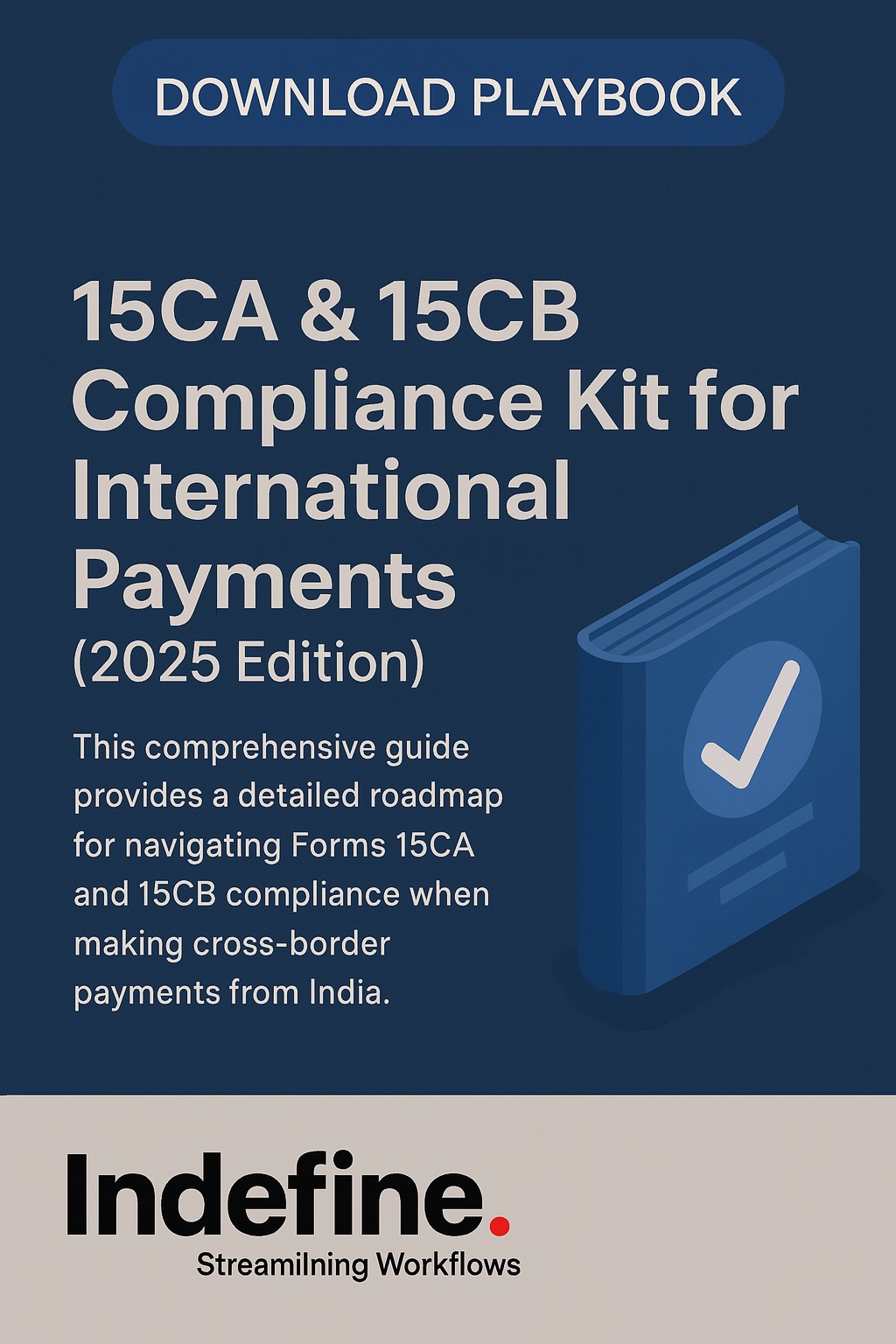The uncomfortable truth: Every month, hundreds of Indian businesses lose thousands of rupees in penalties because they can’t answer one simple question: “When exactly do I need Form 15CA and 15CB for my foreign remittance?” The answer isn’t as straightforward as most finance teams think—and the consequences of getting it wrong in 2025 are more severe than ever.
The million-rupee question keeping CFOs awake: Are you confident you know when to file these forms, or are you gambling with compliance based on outdated knowledge?
Not sure where to start? Let our 15CA & 15CB Certification Services handle your compliance process end-to-end.
What Are Form 15CA and 15CB? Your Foreign Remittance Lifeline

Form 15CA is a mandatory declaration form that must be filed before making any foreign remittance. Think of it as your compliance passport—without it, your bank cannot process most international payments. This online declaration confirms whether your foreign payment is taxable and whether tax has been properly deducted.
Form 15CB is a certificate issued by a Chartered Accountant that’s required for specific high-value taxable remittances. The CA certifies that your payment complies with Indian tax laws and Double Taxation Avoidance Agreement (DTAA) provisions.
Critical 2025 Update: These forms are now fully integrated with digital banking systems, and non-compliance triggers automatic payment blocks at most major banks.
When Do You NEED Form 15CA and 15CB? The Decision Framework That Never Fails
The filing requirements depend on three critical factors that work together:
- Nature of remittance (business vs. personal, taxable vs. non-taxable)
- Transaction amount (above or below ₹5 lakh threshold)
- Exemption status (Rule 37BB coverage, current vs. capital account)
The Ultimate Decision Matrix for 2025
| Scenario | Form 15CA Required? | Form 15CB Required? | Key Legal Authority |
| Taxable remittance ≤ ₹5L | Yes (Part A) | No | Section 195(1) provisions |
| Taxable remittance > ₹5L | Yes (Part C) | Yes | CA certificate mandatory |
| Non-taxable remittance | Yes (Part D) | No | Income Tax Act compliance |
| Rule 37BB exempt | No | No | 33 exempt categories |
| With AO certificate | Yes (Part B) | No | Section 195(2)/(3) provisions |
Critical 2025 Insight: The ₹5 lakh threshold doesn’t automatically exempt all transactions. Taxable business remittances require Form 15CA regardless of amount, while Form 15CB is only required for taxable remittances above ₹5 lakh.
Need expert guidance? Explore our 15CA & 15CB Certification Services for professional support.
Understanding Form 15CA Parts: Your Step-by-Step Filing Guide
Form 15CA has four distinct parts based on your specific situation:
| Part A – For Small Taxable Remittances When to use: Taxable remittances ≤ ₹5 lakh during financial year Requirements: Basic declaration only, no CA certificate needed Processing time: Instant approval in most cases |
Part B – With Assessing Officer Certificate When to use: When you have Section 195(2), 195(3), or 197 certificate from AO Requirements: Upload AO certificate before remittance Benefit: May allow reduced TDS rates |
| Part C – For Large Taxable RemittancesWhen to use: Taxable remittances > ₹5 lakh during financial yearRequirements: Mandatory Form 15CB certificate from registered CAProcessing complexity: Highest, requires CA verification | Part D – For Non-Taxable RemittancesWhen to use: Payments not chargeable to tax under Income Tax ActRequirements: Declaration only, no CA certificateCommon examples: Capital account transactions, certain DTAA-covered payments |
The 33 Exemption Categories Under Rule 37BB: Your Compliance Escape Routes
Complete exemption from Form 15CA and 15CB applies to these categories:
| Investment and Capital Transactions Indian investment abroad in equity capital (shares)Indian investment abroad in debt securitiesIndian investment abroad in branches and subsidiariesLoans extended to non-residents | Trade and Business Payments Advance payment against importsPayment towards imports – settlement of invoiceIntermediary trade transactionsOperating expenses of Indian companies abroad |
| Travel and Personal Remittances Business travel remittancesTravel under basic travel quota (BTQ)Travel for pilgrimage, medical treatment, educationPostal services and courier services | |
Strategic Note: These exemptions were expanded from 28 to 33 categories in 2015, but many businesses still operate with outdated lists.
Overwhelmed? Our 15CA & 15CB Certification Services simplify this process for your team.
The 2025 Game-Changers: What’s New and Critical
| TCS Threshold Revolution TCS threshold increased from ₹7 lakh to ₹10 lakh for most LRS remittances Complete TCS exemption for education remittances funded through loans Enhanced exemption categories providing broader compliance relief | Digital Transformation Impact Mandatory electronic filing for Form 10F regardless of PAN status AI-powered bulk processing enabling 40+ forms per minute vs. 15 minutes manual processing Real-time compliance verification integrated with banking systems |
| Penalty Landscape Changes Section 271-I penalties can reach ₹1 lakh per violation Automatic expense disallowance under Section 40(a)(i) for non-compliance FEMA violations for incorrect disclosure to banks | |
Real-World Scenarios: When You Actually Need These Forms
| Scenario 1: Software Company Paying $30,000 for Microsoft Licenses Payment nature: Taxable (fees for technical services) Amount: Above ₹5 lakh threshold Requirements: Form 15CA (Part C) + Form 15CB TDS implications: Standard software royalty rates apply |
Scenario 2: Manufacturing Company Making ₹3 Lakh Import Payment Payment nature: Import settlement Exemption status: Rule 37BB exempt (advance payment against imports) Requirements: No Form 15CA or 15CB needed Bank documentation: Standard import documents sufficient |
| Scenario 3: Consultant Receiving $50,000 from US Client Payment nature: Professional services (taxable) Amount: Above ₹5 lakh threshold Requirements: Client must file Form 15CA (Part C) + Form 15CB DTAA benefits: May apply with proper documentation |
|
The Filing Process: Your Step-by-Step Compliance Workflow
Phase 1: Pre-Filing Assessment
- Determine payment taxability using Income Tax Act provisions
- Check Rule 37BB exemption list for your specific transaction type
- Calculate aggregate remittances for the financial year
- Assess DTAA applicability if foreign entity is treaty-covered
Phase 2: Form Selection and Preparation
- Choose correct Form 15CA part based on decision matrix
- Engage CA for Form 15CB if taxable amount exceeds ₹5 lakh
- Gather supporting documents including contracts, invoices, certificates
- Verify foreign entity details and payment purpose codes
Phase 3: Submission and Verification
- File forms through income tax portal or offline utility
- e-Verify using DSC or EVC within prescribed timeframes
- Obtain acknowledgment numbers for bank submission
- Monitor compliance status through portal tracking systems
Solution? Invest in professional help—use 15CA & 15CB Certification Services
Strategic Compliance Tips for 2025
Leverage Technology for Compliance
- Implement automated tracking systems for foreign remittance monitoring
- Use AI-powered compliance tools to identify filing requirements
- Integrate with banking APIs for real-time compliance verification
Optimize Using DTAA Benefits
- Obtain Tax Residency Certificates from foreign countries
- Submit Form 10F to claim treaty benefits
- Document treaty positions thoroughly for audit defense
Maintain Comprehensive Audit Trails
- Document exemption rationales with regulatory references
- Maintain CA consultation records for complex transactions
- Prepare penalty defense documentation proactively
The Penalty Avoidance Strategy
Understanding the enforcement landscape is crucial for 2025:
- Section 271-I penalties can reach ₹1 lakh per instance but are avoidable with proper compliance
- Expense disallowance under Section 40(a)(i) can be more costly than penalties
- FEMA violations add regulatory complexity beyond tax implications
Best practice: Establish monthly compliance reviews and quarterly CA consultations to ensure ongoing adherence to evolving requirements.
Conclusion: Transform Compliance Into Competitive Advantage
The question isn’t just whether you need Form 15CA and 15CB—it’s whether you understand the regulatory framework well enough to make that determination confidently, file accurately, and optimize strategically.
In 2025, foreign remittance compliance has evolved from a checkbox exercise to a strategic business function. Companies that master the intersection of tax law, regulatory requirements, and operational efficiency don’t just avoid penalties—they create sustainable competitive advantages in the global marketplace.
The businesses that thrive are those that transform legal complexity into operational excellence, leveraging comprehensive compliance systems, CA partnerships, and technology integration to ensure seamless international operations while maintaining bulletproof regulatory positions.
Are you ready to transform your foreign remittance compliance from a cost center into a competitive advantage, or will you continue gambling with penalties and operational disruptions?
Always consult with qualified legal and tax professionals for specific implementation guidance tailored to your business circumstances and transaction types.


